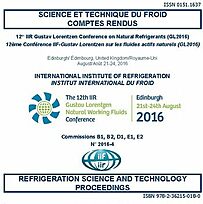
Document IIF
Évaluation des performances d'une pompe à chaleur air-eau utilisant le propane comme frigorigène.
Performance evaluation of a large capacity air-water heat pump using propane as refrigerant.
Numéro : pap. 1090
Auteurs : XU T., SAWALHA S., MAZZOTI W., et al.
Résumé
Heat pump applications working with hydrocarbons as refrigerant have been under significant development along with the gradual phasing-out of conventional HFC systems. In this study, a large capacity air-water heat pump prototype using propane as refrigerant is tested to evaluate its heating performance under different operating conditions. The experimental set-up is briefly explained. The results of the experimental investigations of the heat pump prototype are presented in terms of the COP1, heating capacity and the compressor efficiency. At the design point, the experimental COP1 and heating capacity are 3.43 and 36.59 kW respectively. Experimental results for all test conditions are compared to simulation results generated from the model, which is created by the software IMST-ART. The model is validated through comparisons of those parameters since a good agreement between simulated and experimental data have been found. The maximum discrepancies of COP1 and heating capacity are around 5% and 10% respectively.
Documents disponibles
Format PDF
Pages : 8 p.
Disponible
Prix public
20 €
Prix membre*
Gratuit
* meilleur tarif applicable selon le type d'adhésion (voir le détail des avantages des adhésions individuelles et collectives)
Détails
- Titre original : Performance evaluation of a large capacity air-water heat pump using propane as refrigerant.
- Identifiant de la fiche : 30019024
- Langues : Anglais
- Source : 12th IIR Gustav Lorentzen Conference on Natural Refrigerants (GL2016). Proceedings. Édimbourg, United Kingdom, August 21st-24th 2016.
- Date d'édition : 21/08/2016
- DOI : http://dx.doi.org/10.18462/iir.gl.2016.1090
Liens
Voir d'autres communications du même compte rendu (140)
Voir le compte rendu de la conférence
Indexation
-
Thèmes :
Pompes à chaleur à usage domestique;
Hydrocarbures - Mots-clés : Air-eau; R290; Pompe à chaleur; Performance; Modélisation; Experimentation
-
Modeling and simulation of the impact of soft f...
- Auteurs : LLOPIS-MENGUAL B., NAVARRO-PERIS E., BARCELÓ RUESCAS F., CORBERÁN J. M.
- Date : 2022
- Langues : Anglais
- Source : 2022 Purdue Conferences. 19th International Refrigeration and Air-Conditioning Conference at Purdue.
- Formats : PDF
Voir la fiche
-
Benefits and reliability of air-to-water heat p...
- Auteurs : CAPANELLI S. M.
- Date : 31/08/2021
- Langues : Anglais
- Source : 13th IEA Heat Pump Conference 2021: Heat Pumps – Mission for the Green World. Conference proceedings [full papers]
- Formats : PDF
Voir la fiche
-
Comparison of the energy consumption of ground-...
- Auteurs : TAMMARO M., MONTAGUD C., CORBERÁN J. M., et al.
- Date : 21/08/2016
- Langues : Anglais
- Source : 12th IIR Gustav Lorentzen Conference on Natural Refrigerants (GL2016). Proceedings. Édimbourg, United Kingdom, August 21st-24th 2016.
- Formats : PDF
Voir la fiche
-
Experimental study on the performance of R290 a...
- Auteurs : LEI B., SHI H., WANG C., WU J., ZHANG L.
- Date : 21/08/2023
- Langues : Anglais
- Source : Proceedings of the 26th IIR International Congress of Refrigeration: Paris , France, August 21-25, 2023.
- Formats : PDF
Voir la fiche
-
Performance modeling and monitoring of a high-t...
- Auteurs : DUMONT E., LEPORE R., FRERE M.
- Date : 16/08/2015
- Langues : Anglais
- Source : Proceedings of the 24th IIR International Congress of Refrigeration: Yokohama, Japan, August 16-22, 2015.
- Formats : PDF
Voir la fiche
